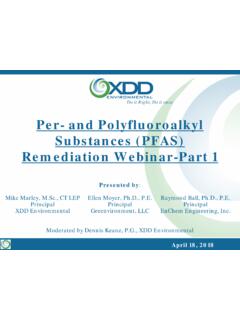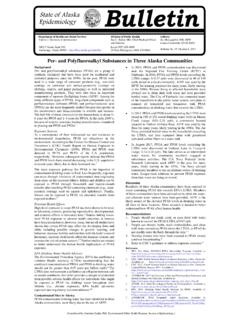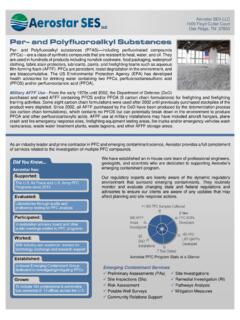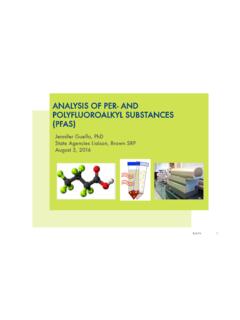Transcription of Per- and Polyfluoroalkyl Substances (PFAS) Remediation ...
1 Presented by:Mike Marley, , CT LEPP rincipalXDD EnvironmentalDo it Right, Do it oncePer- and Polyfluoroalkyl Substances ( pfas ) Remediation WorkshopEllen Moyer, , , LLCR aymond Ball, , Engineering, 18, 2017 Moderated by Dennis Keane, , XDD EnvironmentalAgenda Introduction to workshop and Objectives Dennis Keane General audience questions Properties, Uses, Occurrence and Concerns with pfas Ellen Moyer Exercise 1 pfas Remedial Options for Source and Plume Areas Mike Marley Exercise 2 Break (5 minutes) Integrating Key Data in the Characterization Phase Mike Marley Exercise 3 Exercise 4 Adsorption Case Studies Mike Marley Exercise 5 Chemical Oxidation Case Study Raymond Ball Wrap-Up / Summary of Current State of the Practice Mike Marley Additional Discussion Dennis Keane 2 Overview New and fast-changing targets Which pfas ? Which cleanup levels? Can we measure all pfas ? pfas Remediation challenges Low cleanup levels Numerous pfas chemicals are all being or need to be remediated?
2 Transformation vs. destruction/mineralization Risk of making things worse or not remediating adequately? Are waste management issues fully understood and addressed? To help address issues Collect appropriate site characterization data Perform treatability and/or pilot testing3 Properties, Uses, Occurrence and Concerns with pfas 4 What are pfas ? Per- and Polyfluoroalkyl Substances A diverse class of synthetic chemicals in which at least one C is fully fluorinated C-F bonds are the shortest and strongest covalent bonds in nature Believed to be ~6,000 pfas so far5 What are pfas ? Carbon chains with attached F 2 to 18 C Per FAS all C in the chain are bonded to F Most desired manufactured chemicals are per Poly FAS not all C in the chain are bonded to F Most polys are unintended byproducts of manufacturing Many are precursors to pers Other atoms can include O, H, S, N, others6 What are pfas ? Produced in the largest amounts in the US: Perfluorooctanoic acid - PFOA (C8) Perfluorooctane sulfonate - PFOS (C8) pfas properties: Water soluble Low volatility Many resist biodegradationPFOANIEHS National Institutes of Health78 Uses pfas resist heat, oil, grease, and water Used in industry and consumer products worldwide since the 1950s products contain a mix of carbon lengths and impurities Waterproof clothes, non-stick cookware, take-out containers Wire insulation Paper and paints Fire-fighting foams Carpet PropertiesPropertyPFOAPFOSB enzeneChemical FormulaC8HF15O2C8HF17O3SC6H6 Molecular Weight (g/mol) Point (oC) Pressure (mm Hg at 25 oC) ~ s Law Constant @ 25oC (unitless)Not measurableNot (temperature asspecified)11537179 (at 25 oC)Solubility in Water (mg/L)~9,500 (at 25 oC)680 (temp.)
3 Not stated)1,780(at 25 oC)USEPA 2016 USEPA 20169 Physical-Chemical Properties of Select Short-Chain PFAS1010/19/201711 Primary Sources Point or Direct Released in large quantities from primary manufacturing facilities Secondary Manufacturing incorporation of PFC raw materials into industrial and consumer products The use of AFFFs to fight fires is a direct pathway to the environment (Connection to DoD)1212 Secondary Sources Indirect Commercial and consumer products have a finite lifetime. Dispose to landfills WWTP Air emissions Trace chemistry transformation mostly degradation by products (TOP Assay)131314 Occurrence Found worldwide in soil, air, water, wildlife, and humans Including the Arctic and Antarctic 2015 study by National Health and Nutrition Examination Survey: pfas found in 97 percent of human blood samples 2013-2015 Safe Drinking Water Act testing: pfas found in 66 water supplies serving more than 16 million Americans in 33 states with at least one sample at or above EPA drinking water health advisories Tendency for large dilute plumes Difficult to sample Cross-contamination issues Difficult to laboratory analyze Some pfas not detected by commercial.
4 Antarctic,_adelie_penguins_(js) in Tap Water and at Industrial and Military SitesCopyright Environmental Working Group, Reprinted with Most attention with longer-chain pfas (C8 or greater , PFOA, PFOS) Persist, travel long distances, and bioaccumulate Potential health effects being studied: Affect developing fetus and child including learning and behavior Decrease fertility Disrupt hormones Increase cholesterol Suppress immune system Increase cancer risk1610/19/201717 Standards and Guidelines EPA established health advisories for PFOA and PFOS 70 ng/L or ppt (individually and combined) For lifetime exposure from drinking water) Based on lab studies of effects on rats and mice and epidemiological studies of exposed human populations EPA has no plans to establish Maximum Contaminant Levels EPA plans to develop Regional Screening Levels for site cleanup Other requirements vary widely Some states and countries are looking at more than PFOA and PFOS In the absence of federal MCLs, state standards lack enforcement teeth1819 Ellen ask for updated graphic, as powerpoint2021 Analytical Challenges Low detection limits required Cross-contamination during sampling Deciding which analytes to quantify of the many that exist Standards not available for many analytes Fast-changing regulatory requirements and analytical methodsPFAS Analysis Standard Method Primary methodology Method 537 Determination of Selected PerfluorinatedAlkyl Acids in Drinking Water by Solid Phase Extraction (SPE)
5 And Liquid Chromatography/Tandem Mass Spectrometry (LC/MS/MS), Sept,2009 EPA Technical Advisory 815 B 16 021 pfas compounds can exist as linear & branched isomers Method 537 addresses both for PFOS but not PFOA Discrepancies in PFOA analysis addressed in Tech Advisory Drinking water method Amenable to a specific 14 cmpdPFAS target list2210/19/201723 Other LC/MS/MS Methodologies Method 537 not amenable to expanded list of compounds 500 series DW methods not supposed to be modified Laboratory proprietary methods to address longer compound lists / sample matrices other than DW Isotope dilution approach addition of known amount ofisotopically enriched, compound specific internal standards Different or multiple SPE cartridges EPA releasing 2 additional methods for comments GW & soil/tissue (summer/fall) check with Jim O. about status in 10/20172424 Fluoride and Total Organic Fluorine Analysis Fluoride analysis can be used to: Evaluate extent of biological or chemical Remediation that releases fluoride from pfas A drawback is high detection limits of ~20 ug/L Drinking water standards/guidelines: Public Health Service recommends mg/L to prevent cavities EPA MCL mg/l and secondary MCL mg/L Concerns about thyroid, brain, and other impacts Total organic fluorine an emerging technique could be useful to.
6 Locate pfas plumes Verify Remediation is complete25 Transformation and Precursors Pers don t naturally transform Oxidizable polys should eventually transform to pers Biotic or abiotic transformation Polys cleave at a weak spot ( , a carbon not fully fluorinated) Total Oxidizable Precursors (TOP) analysis quantifies precursors to help assess the total mass and risk of PFAS2610/19/20172710/19/20172810/19/2017 29 References EPA. 2016. Health Advisories for PFOS and PFOA. Environmental Working Group. 2017. Toxic Fluorinated Chemicals in Tap Water and at Industrial or Military Sites. Kj lholt, J., Allan Jensen, and M. Warming. 2015 Short-chain Polyfluoroalkyl Substances ( pfas ). A literature review of information on human health effects and environmental fate and effect aspects of short-chain pfas : Buechler, Karla. 2017. The Analysis of Polyfluorinated Alkyl ( pfas ) including PFOS and PFOA June 27, 2017.
7 Buechler, Karla, 2017. Closing the pfas Mass Balance: The Total Oxidizable Precursor (TOP) Assay May 15, 2017. : Properties, Uses, Occurrence and Concerns You ve done an initial subsurface investigation of a pfas release site and the client wants to clean it up Groundwater flows from the site toward an offsite drinking water well You analyzed groundwater samples for pfas by Method 537M and detected PFOS and PFOA at concentrations 10 times state standards (no other pfas were detected, nor were VOCs or other types of chemicals) What additional information would you target for the next round of investigation to determine the nature and extent of contamination?3132 pfas Remedial Options for Source and Plume Areas33 Physical-Chemical PropertiesPropertyPFOAPFOSB enzeneChemical FormulaC8HF15O2C8HF17O3SC6H6 Molecular Weight (g/mol) Point (oC) Pressure (mm Hg at 25 oC) ~ s Law Constant @ 25oC (unitless)Not measurableNot (temperature asspecified)11537179 (at 25 oC)Solubility in Water (mg/L)~9,500 (at 25 oC)680 (temp.)
8 Not stated)1,780(at 25 oC)USEPA 2016 USEPA 201634 Overview Based on the physical/chemical properties of pfas (the higher C pfas ) High molecular weight = potential for sieving / filtration High Koc = potential for adsorption Charged group = potential for ion exchange Low VP = not suitable for SVE at ambient temperatures Low H = not suitable for stripping from groundwater at ambient temperatures Biodegradation Very limited research to date showing biodegradation of Pers No accumulation of byproducts or Fluoride in studies raises questions Evidence of transformations of Polys Question on whether can treat to the proposed standards Mother nature will likely find a way to degrade Pers with time? Oxidative / reductive technologies Showing promise, but some unanswered questions Common theme is high energy and / or diverse reactive species needed Thermal how hot?35 Remedial Technologies with Success in pfas Treatment(Success may have been only achieved at bench scale level) Physical treatment/removal Filtration/reverse osmosis* Adsorption/ion exchange (IX)* Excavation + disposal / isolation In-situ stabilization Chemical Oxidation / Reduction Various high energy oxidant / reductant systems Sonolysis Photolysis Biotransformation Partial?
9 Not for C-F bond? Other Destruction at high temperature > 1,100 oC Pyrolysis Can enhance removal at lower temperatures , thermal desorption Electro-chemical / catalytic * Typically associated with ex-situ treatment Summary of Ex-Situ Water Treatment Options Evaluated 36E. Dickenson and C. Higgins, Treatment Mitigation Strategies for Poly- and Perfluoroalkyl Substances , Water Research Foundation, Nano-Filtration (NF) pfas have molecular weight cutoff (MWCO) of approximately 300 - 500 Daltons Measure of size restriction to pass through filter media NF MWCO > 200 Daltons, therefore >90% effective most pfas Ultra and micro-filtration low effectiveness Reverse Osmosis Polymers used have spaces on the order of 100 200 Daltons >90% effective most pfas Concentrated waste streams result / require treatment Typically incineration at > 1100 oC PerfluorAd not really filtration but pretreatmentFiltrationEssentially Sieving of pfas moleculesFor every zone of your plume, we ve got you covered!
10 Page 2016 Tersus Environmental, LLC. All Rights Principle of Operation Added to PFASs contaminated water in stirring reactor Dosing rate adjustable to PFASs concentration or target Micro flocs are generated Flocs removable by precipitation& filtration 95%+ PFASs removalattainable Non detect concentrations with GAC/PACpolishing3839 Adsorption/Ion Exchange(most commonplace) Carbon-based systems Ex-situ activated carbon systems (granular [GAC] or powered [PAC]) In-situ injectable carbon-based systems Questions exist on design / long term performance Clays or blend of sorbent-based systems , Rembind , MatCARE Part isolation? Synthetics resins gaining traction due to capacity/effectiveness Combination IX and adsorption Zeolites? in R&D Treatability studies are essential Not all GAC are created equal Carbon source and manufacturing can impact capacity and effectiveness GAC has been used for more than 15 years in over 30 large installations for both drinking water and pfas Remediation applications (also for POET)









